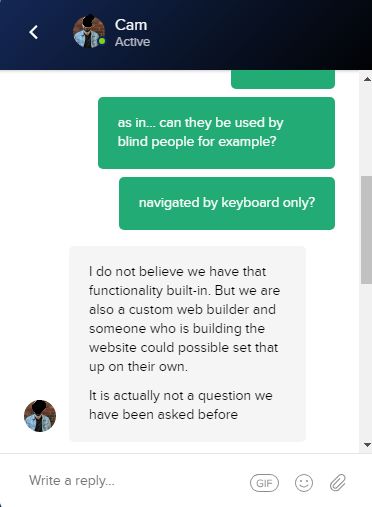
A typical dialogue window with customer support
Sometimes I come across adverts for this or that easy solution to build a website or to make an e-book, an online course or customized apps. It’s fairly easy to build almost anything now, under a couple of minutes, as the adverts try to convince us. So you click on the link and read through the website, marvel at the seller’s wonderful credentials, the longtime experience in web design and content management and extraordinary feats they display, to convince you, the buyer, that this is the right choice. And here comes the “one-time special offer”, “it’s now or never”, “take it or leave it” button. And up pops the tiny window on the right corner of the page: “Hi, can we help you? We’re here and we’d like to talk you into buying our incredibly convenient solution!”
The past couple of months, I started playing this little game. It’s called “The Trick Question” and it goes like this:
I start a dialogue with the online customer service representative. And I ask my favorite question: “Do you take accessibility into account when creating these templates for e-books/websites/whatever you are selling?”

“I am not quite sure I am understanding what you are asking.”
The answer? Almost always is somewhere on the line of “Come again?” or “I am not sure I understand what you are asking.” or “What do you mean by that?”.
And I go on explaining about screen readers and color contrast and headings and reading order and focus windows and keyboard navigation and captcha and carousels and animations and how all these details can be barriers. They thank me for my feedback. They promise to take it up with their supervisors. And I am pretty sure this is where it all ends for them.
Now, let me tell you why this is a trick question, although, it shouldn’t really be.
In my opinion, these notions should be taught in all web design classes. Just like when you build a new house, you have to think of a fire escape and (hopefully) a safety landing and doors wide enough to fit a wheelchair and all these other details that are not mere whims, but a Human Right. Here, I said it. Accessibility should not be optional. It should be built in. Because we can build houses and websites and ebooks and online courses that are accessible to everybody.
Whether your company is located in the EU, or the US, or Canada, there is a law that requires you to take into consideration the accessibility of your website builder or e-book or whatever digital product you might upload online.
Is everybody required to make their products accessible? By law, you must make new and significantly refreshed public websites accessible if you are a private or non-profit organization with 50+ employees or a public sector organization.

Another example of a dialogue with a Toronto-based company CSR
So, if you are a Canadian start-up, fresh out of college web design graduates, trying to make a buck with a new website builder or online course builder, do you have to comply? Well, if you take the law ad-litteram, maybe not. You’re not the government. You’re not a municipality… You don’t have 50+ employees. So, maybe, at this point, a reaction like the one pictured above from your customer service representative is not necessarily a shock. Is it a surprise? Yes. Accessibility should be common sense already. AODA is not a new law. It’s been around for quite some time, since 2005. There are Web Accessibility courses, webinars, tutorials readily available. Some are free. You just need to be aware that Accessibility is “a thing” and to care enough about your potential users.
Here is my point: Maybe you don’t have to do it. But should you do it? Yes, please. Please do it.
“Yes, but how many of my potential users are disabled, really?”
Here’s an answer that might surprise you. 1 in 7. According to Statistics Canada, 1 in 7 Canadians lives with one or more disabilities. Are you ready to ignore 1 in 7 potential clients?
“Yes, but my product doesn’t really address people with disabilities”, you might think. “I sell parking meters and blind people don’t pay for parking, because they don’t drive. ‘Cause they’re blind. Right?”
Well. They don’t drive yet. But driverless cars are just about to hit mass production and guess what, parking fees will still be a thing. Or maybe I am going out to a concert with my blind friend and she offers to pay for the parking but can’t. And decides to sue you. So if you manufacture those fancy parking meters or kiosks, and there isn’t a physical keypad, with rims, next to your amazing touch screen, you might be in trouble. Not just yet. But soon.

“It is actually not a question we have been asked before”
“Yes, but my educational product isn’t really for people with disabilities, ’cause there’s only so much they can do. Right?”
Well… Who are we to decide what someone else can and cannot do? I had the opportunity to meet amazing professionals in the Accessibility field. Some of them had visible disabilities, others had some invisible disabilities that they choose not to mention. They are active, they are educated, they are all they can be and live fulfilling lives.
Now let’s talk about this wonderful start-up, set up by recent college or university grads. They just want to offer a tool to help anybody build beautiful, functional websites – in just a couple of minutes. They offer templates. You just click and choose, a header here, a footer there, one beautiful button, a pretty font – add a splash of color to make it pop – some social media icons, three images that are remotely connected with what your company is doing – free, ’cause photographers are known to live by photosynthesis – and poof! Here’s your website.
What if a Not for Profit organization uses your web-builder to come up with a brand new website in just a couple of minutes, as advertised, and their website is not accessible? Guess who’s liable for this one, in case anybody (and I mean, literally anybody) sues them for not having access to that particular information/feature.
Did you know that beginning January 1, 2021, all public websites and web content posted after January 1, 2021 must meet WCAG 2.0 Level AA? That is: they have to be accessible. ALL of them. This means: accessible to screen readers, easy to navigate by keyboard only, accessible in terms of color contrast (no fancy grey over black, people can’t see that), accessible carousels, accessible radio buttons, accessible images, accessible tables (no more pictures of tables without any alt text or description) and so on…
Some companies and organizations in the US didn’t think about it too much, either. And a very strange thing happened. They were sued. According to the Legal edition of “Accessibility in the News“, 2018 was a record-setting year for website accessibility activity in the US. Financial services, restaurants and grocers, casinos, pizza chains, wineries, sports teams, universities, and others all found themselves on the receiving end of complaint letters and litigation regarding their digital environments. The number of ADA Title III lawsuits filed in federal court in 2018 hit a record high of over 10,000.
“Yes, but we’re in Canada”.
Yes, but we also have a law, at least in Ontario. The Accessibility for Ontarians with Disabilities Act. Soon, there will be an Accessible Canada Act. Bill C-81 is not perfect, but they are working on it. So why wait until there is an official body able to punish you? Why not build templates that are already accessible? It’s not rocket science! Why not set-up all your exports, whether they’re PDF or HTML or Epub or whatever you may offer – to be accessible from the start? Why not do the decent thing and require your web designers and your coders to at least be aware that Accessibility “is a thing”. And that Accessibility matters?
Come on, Canada. We can do this. It’s the right thing to do.

Fantastic article, thank you for actually saying this in plain words. I recently had to prepare a presentation and after I finished putting the content together my next goal was to make it accessible. That is when my eyes opened and I have realized how hard it is for some people to simply navigate through the day-to-day tasks that most of us take for granted. Thank you for the education and awareness work that you do!
Thank you, Simona, for your kind words. I am very happy you find my articles useful, please share them with your friends.